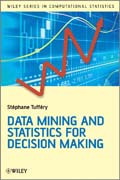
INDICE: Preface Foreword Contents Overview of data mining 1.1. What is datamining? 1.2. What is data mining used for? 1.3. Data Mining and statistics 1.4. Data mining and information technology 1.5. Data mining and protection of personal data 1.6. Implementation of data mining The development of a data mining study 2.1. Defining the aims 2.2. Listing the existing data 2.3. Collectingthe data 2.4. Exploring and preparing the data 2.5. Population segmentation 2.6. Drawing up and validating predictive models 2.7. Synthesizing predictive models of different segments 2.8. Iteration of the preceding steps 2.9. Deploying the models 2.10. Training the model users 2.11. Monitoring the models 2.12.Enriching the models 2.13. Remarks 2.14. Life cycle of a model 2.15. Costs ofa pilot project Data exploration and preparation 3.1. The different types of data 3.2. Examining the distribution of variables 3.3. Detection of rare or missing values 3.4. Detection of aberrant values 3.5. Detection of extreme values 3.6. Tests of normality 3.7. Homoscedasticity and heteroscedasticity 3.8. Detection of the most discriminating variables 3.9. Transformation of variables 3.10. Choosing ranges of values of continuous variables 3.11. Creating new variables 3.12. Detecting interactions 89 3.13. Automatic variable selection 3.14. Detection of collinearity 3.15. Sampling Using commercial data 4.1. Data used in commercial applications 4.2. Special data 4.3. Data used by business sector Statistical and data mining software 5.1. Types of data mining and statistical software 5.2. Essential characteristics of the software 5.3. The main software packages 5.4. Comparison of R, SAS and IBM SPSS 5.5. How to reduce processing time An outline of data mining methods 6.1. A note on terminology 6.2. Classification of the methods 6.3. Comparison of the methods 6.4. Using these methods in the business world Factor analysis 7.1. Principal component analysis 7.2. Variants of principal component analysis 7.3. Correspondence analysis 7.4. Multiple correspondence analysis Neural networks 8.1. General information onneural networks 8.2. Structure of a neural network 8.3. Choosing the trainingsample 8.4. Some empirical rules for network design 8.5. Data normalization 8.6. Learning algorithms 8.7. The main neural networks Automatic clustering methods 9.1. Definition of clustering 9.2. Applications of clustering 9.3. Complexity of clustering 9.4. Clustering structures 9.5. Some methodological considerations 9.6. Comparison of factor analysis and clustering 9.7. Intra-class andinter-class inertias 9.8. Measurements of clustering quality 9.9. Partitioning methods 9.10. Hierarchical ascending clustering 9.11. Hybrid clustering methods 9.12. Neural clustering 9.13. Clustering by aggregation of similarities
- ISBN: 978-0-470-68829-8
- Editorial: John Wiley & Sons
- Encuadernacion: Cartoné
- Páginas: 696
- Fecha Publicación: 04/02/2011
- Nº Volúmenes: 1
- Idioma: Inglés
